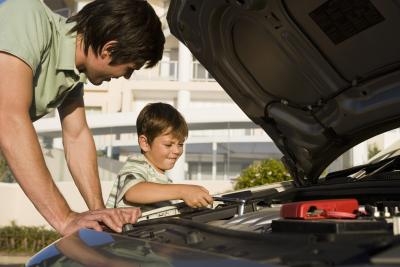
The 1994 Toyota Tercel uses an in-tank electric fuel pump with a vacuum system to provide the engine with the proper fuel pressure. This helps your Tercel 1.5L engine provide a gas mileage of 35 mpg in the highway and 30 mpg in the city. For the most part, other than maintenance service, you will need to replace a component like the fuel pump every once in a while. Fortunately, this is a repair job you can perform at home without using special tools.
Open the hood, disconnect the ground (black) battery cable with a wrench, and locate the fuel filter on the firewall by the passenger's side. Place a shop rag around the fuel line connected to the bottom of the filter.
Hold the molded nut at the bottom of the filter with an open-end wrench, and slowly loosen the line retaining nut connected to the bottom of the filter with a line wrench, just enough to release the fuel pressure in the line. Absorb the fuel that leaks from the line with the shop rag, and then tighten the fuel line with the line wrench.
Loosen the fuel filler cap, and remove the back seat cushion by hand and place it outside of your Tercel. Locate the fuel pump assembly access door on the floor where the rear seat was located, and unplug the electrical connector on the door.
Unfasten the access door mounting bolts with a Phillips screwdriver, and remove the door. Through the access hole, you will see the fuel pump/sending unit bracket assembly mounted on the top of the fuel tank.
Disconnect the pump assembly outlet fuel pipe with a backup wrench on the line fitting nut and a line wrench on the retaining nut. Disconnect both return fuel hoses from the bracket fittings with a pair of rib joint pliers.
Unfasten the mounting bolts from the fuel pump/sending unit bracket assembly with a Phillips screwdriver. Lift the fuel pump assembly out of the fuel tank, and turn the assembly upside down. Unscrew the fuel cut-off valve (small cylinder) attached to the underside of the bracket assembly with a Phillips screwdriver.
Unscrew the electrical wires from the pump bracket with a small wrench. Disconnect the wires and unfasten the sending unit, which holds the long wire with the float at the end, using the Phillips screwdriver, and remove it from the pump assembly.
Pull the bottom of the fuel pump off the base, unplug the pump electrical connector, and detach the pump from the small hose with a pair of rib joint pliers. With the fuel pump free from the bracket assembly, detach the strainer at the bottom of the pump with a small slotted screwdriver.
Attach a new strainer to the bottom of the new fuel pump. Position the new pump in the pump bracket, and attach the small hose and electrical connector to the top of the pump. Secure the bottom of the pump into the bracket base.
Fasten the sending unit to the fuel pump bracket with the Phillips screwdriver, and attach the electrical wires to the bracket with the small wrench.
Reinstall the fuel cut-off valve (small cylinder) to the underside of the bracket assembly with the Phillips screwdriver and the fuel pump assembly into the fuel tank with a new O-ring seal on the tank opening, and fasten the pump assembly to the fuel tank with a Phillips screwdriver.
Attach the return fuel hoses to the bracket fittings with the pair of rib joint pliers, and connect the outlet pipe using the backup wrench and line wrench.
Replace the access door and tighten the mounting bolts with the Phillips screwdriver, and plug in the electrical connector.
Replace the back seat cushion, and tighten the fuel filler cap.
Connect the ground (black) battery cable with the wrench, and close the hood.
Turn the ignition key to the "On" position to pressurize the fuel system, check for fuel leaks around the tank and lines area under the vehicle. Start the engine, check again for fuel leaks, and turn off the engine.